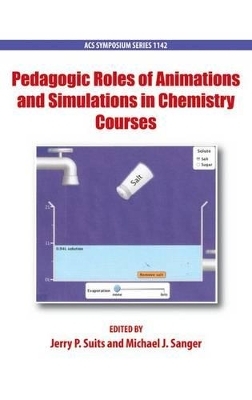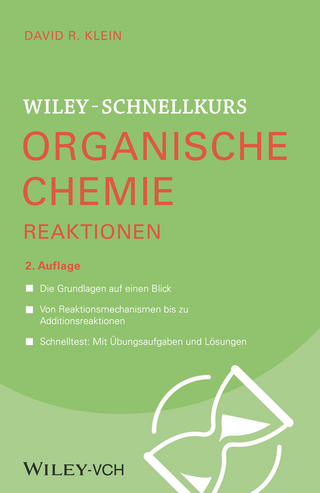
Pedagogic Roles of Animations and Simulations in Chemistry Courses
Oxford University Press Inc (Verlag)
978-0-8412-2826-9 (ISBN)
- Keine Verlagsinformationen verfügbar
- Artikel merken
Chemistry can be a very difficult topic for students to understand, in part because it requires students to think abstractly about the behaviors and interactions of atoms, molecules, and ions. Visualizations in chemistry can help to make chemistry at the particulate level less abstract because students can actually "see" these particles, and dynamic visualizations can help students understand how these particles interact and change over time as a reaction occurs. The
chapters in this book are divided into four categories: Theoretical aspects of visualization design, design and evaluation of visualizations, visualizations studied by chemical education researchers, and visualizations designed for the chemistry classroom. Chapters 2-4 of this book focus on
theoretical issues and concerns in developing and using animations and simulations to teach chemistry concepts. The theoretical frameworks described in these chapters not only include learning theories [such as Behaviorism, Cognitive Load Theory, and Vygotsky's Zone of Proximal Development], but also describe design principles that are informed by educational research on learning with multimedia. Both of these frameworks can be used to improve the way dynamic visualizations are designed,
created, and utilized in the chemistry classroom. Chapters 5-8 of this book provide two examples of paired articles, in which the first chapter introduces and describes how the dynamic visuals were designed and created for use in chemistry instruction and the second chapter describes a chemical education
research study performed to evaluate the effectiveness of using these dynamic visuals for chemistry instruction. Chapters 5 and 6 focus on interactive simulations created as part of the PhET Interactive Simulations Project. Chapters 7 and 8 focus on the virtual-world program Second Life and how it is being used to teach chemistry lessons. Chapters 9-14 of this book describe the results of chemical education research studies on the use of animations and simulations. Chapters 15-17 describe how
specific dynamic visualization programs and modules were designed and how they should be utilized in the chemistry classroom to improve student learning.
Jerry P. Suits is affiliated with the Department of Chemistry and Biochemistry at the University of Northern Colorado. Michael J. Sanger is affiliated with the Department of Chemistry at Middle Tennessee State University.
Dedication ; 1. Dynamic Visualizations in Chemistry Courses ; Jerry P. Suits and Michael J. Sanger ; 2. Explanatory Models for the Research & Development of Chemistry ; Visualizations ; Mike Stieff and Stephanie Ryan ; 3. Designing and Implementing Effective Animations and Simulations for ; Chemistry Learning ; Ruth N. Schwartz, Catherine Milne, Bruce D. Homer, and Jan L. Plass ; 4. Linking Animation Design and Usage to Learning Theories and Teaching ; Methods ; Roberto Ma. Gregorius ; 5. Insights from Using PhET's Design Principles for Interactive Chemistry ; Simulations ; Kelly Lancaster, Emily B. Moore, Robert Parson, and Katherine K. Perkins ; 6. Animation or Simulation: Investigating the Importance of Interactivity for ; Learning Solubility Equilibria ; Sevil Akaygun and Loretta L. Jones ; 7. Virtual Worlds and Their Uses in Chemical Education ; Kurt Winkelmann ; 8. Using Virtual Worlds in the General Chemistry Classroom ; W. L. Keeney-Kennicutt and Z. H. Merchant ; 9. How a Qualitative Study with Chemistry Instructors Informed Atomic ; Level Animation Design ; Resa M. Kelly ; 10. Use of an Interactive Computer-Simulated Experiment To Enhance ; Students' Mental Models of Hydrogen Bonding Phenomena ; Jerry P. Suits and Niwat Srisawasdi ; 11. Making the Unseen Seen: Integrating 3D Molecular Visualizations in ; Elementary, High School, and Higher Education ; Miri Barak ; 12. The Effect of Student-Constructed Animations versus Storyboards on ; Students' Mental Rotation Ability, Equilibrium Content Knowledge, and ; Attitudes ; Vickie M. Williamson, James T. Watkins, and Kenneth C. Williamson III ; 13. How Does the Order of Viewing Two Computer Animations of the ; Same Oxidation-Reduction Reaction Affect Students' Particulate-Level ; Explanations? ; Deborah P. Rosenthal and Michael J. Sanger ; 14. The Future of Computer Simulations Designed for Classroom ; Instruction ; S. Khan ; 15. Designing Analogy-Based Simulations To Teach Abstractions ; Colin A. Ashe and David J. Yaron ; 16. Teaching Tools for Organic and Bio-Organic Chemistry ; Steven A. Fleming ; 17. Using Visualizations of the Science Behind Climate Change To Change the ; Climate of Science Teaching ; B. E. Martin and P. G. Mahaffy ; Editors' Biographies ; Indexes ; Author Index ; Subject Index
| Reihe/Serie | ACS Symposium Series |
|---|---|
| Verlagsort | New York |
| Sprache | englisch |
| Maße | 162 x 230 mm |
| Gewicht | 790 g |
| Themenwelt | Kinder- / Jugendbuch ► Sachbücher |
| Schulbuch / Wörterbuch | |
| Naturwissenschaften ► Chemie ► Organische Chemie | |
| Sozialwissenschaften ► Pädagogik | |
| ISBN-10 | 0-8412-2826-4 / 0841228264 |
| ISBN-13 | 978-0-8412-2826-9 / 9780841228269 |
| Zustand | Neuware |
| Haben Sie eine Frage zum Produkt? |
aus dem Bereich


